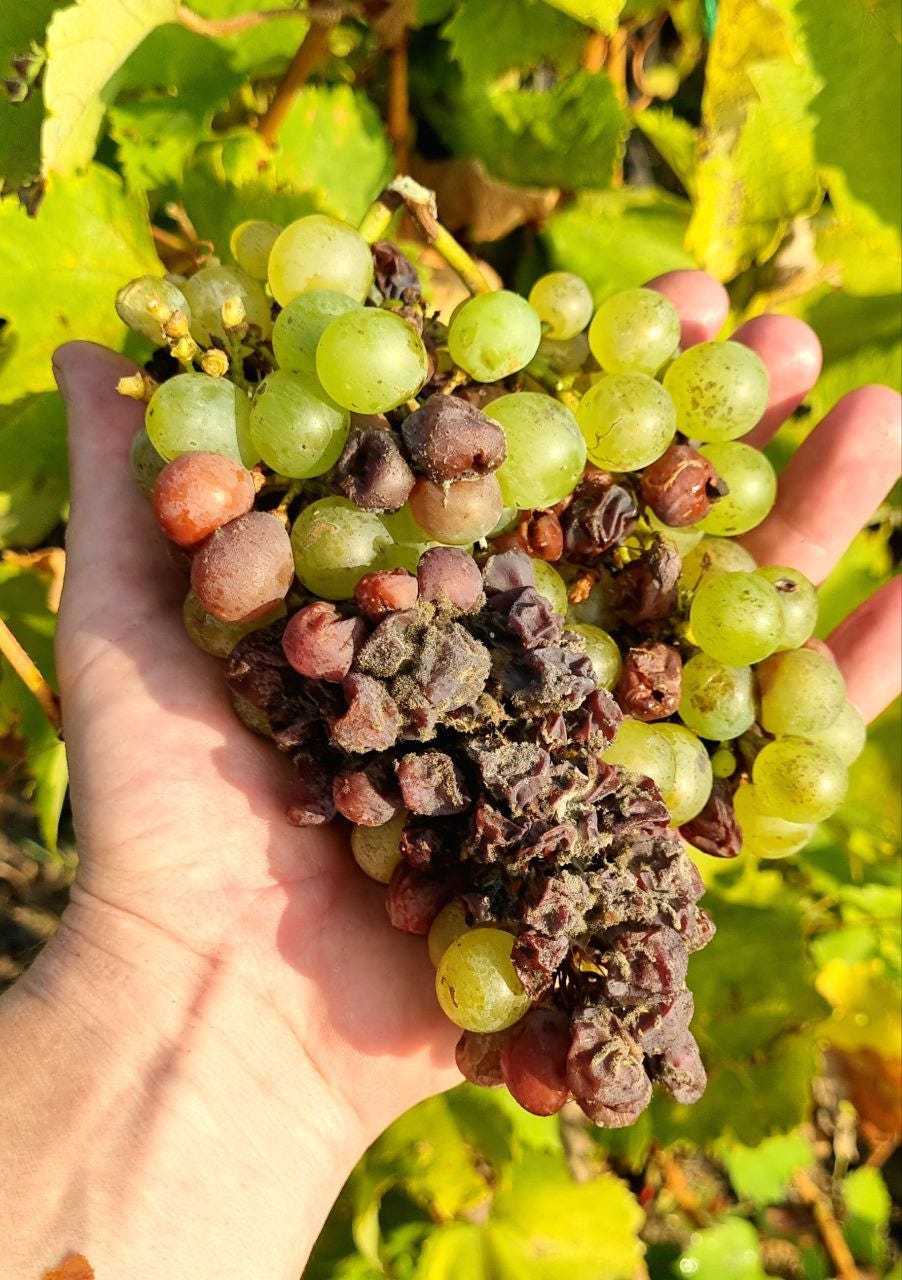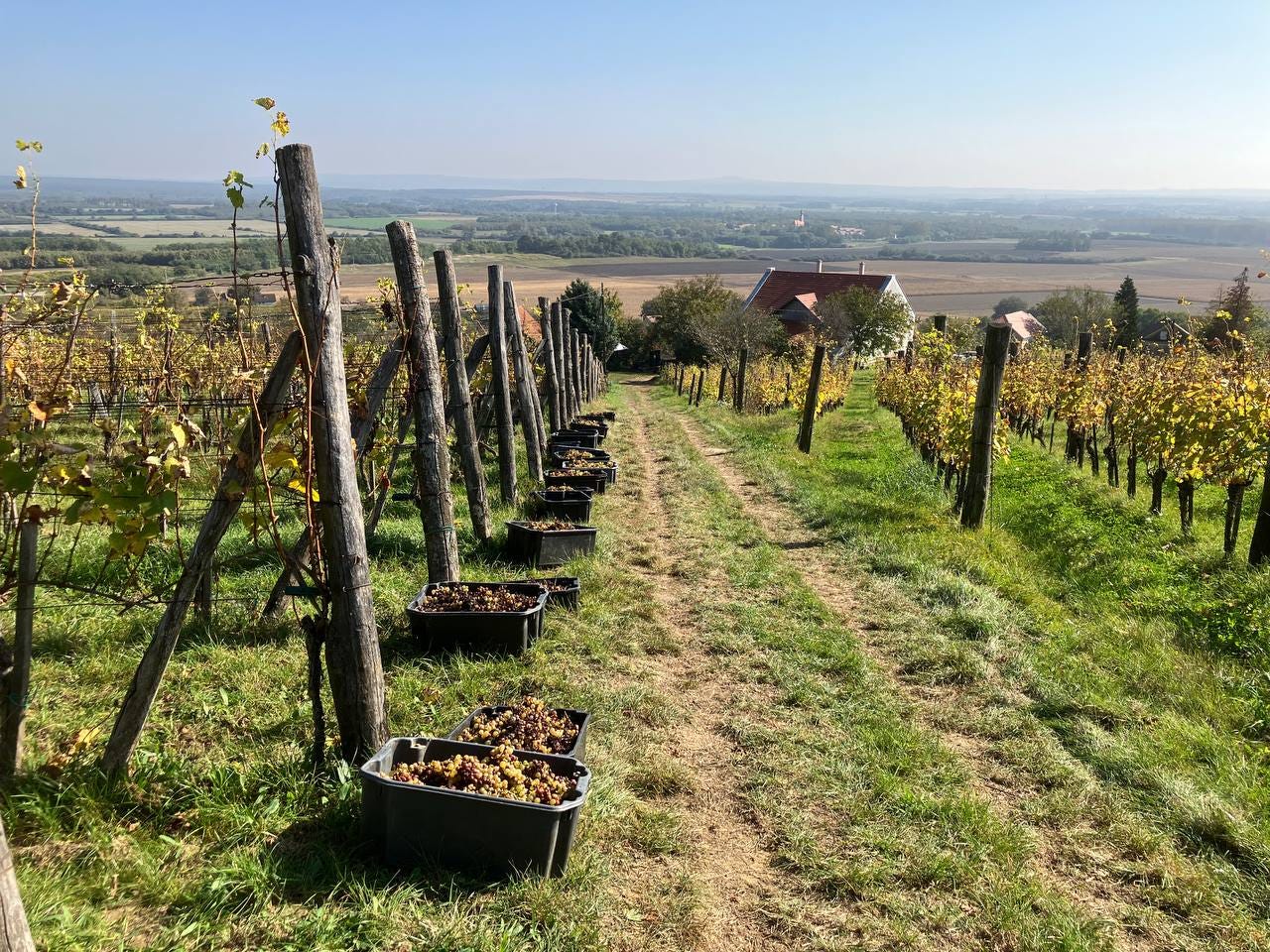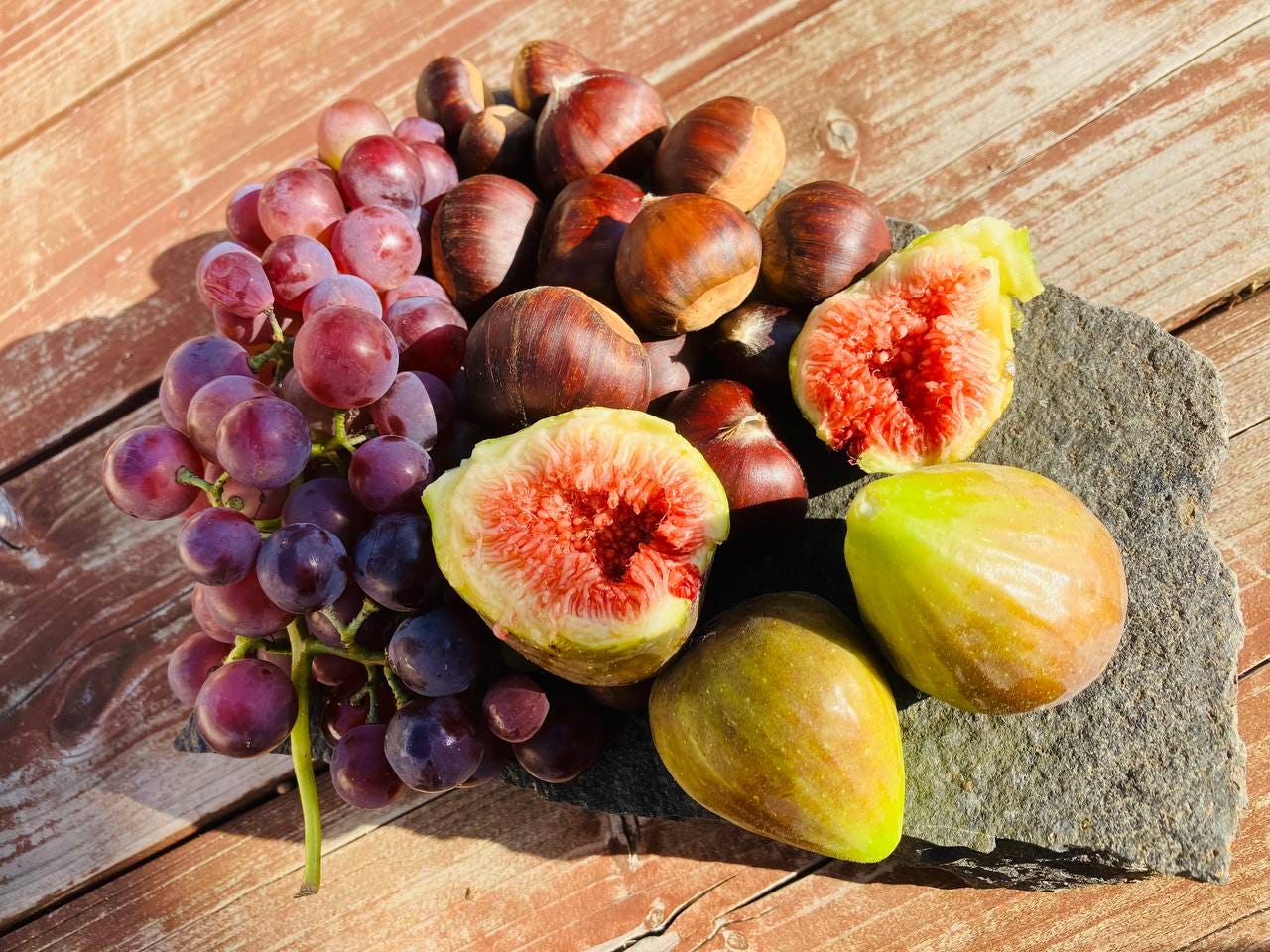A szürettel kapcsolatban annyi közhelyet lehetne pufogtatni, hogy szinte kényszeresen keresem azt a perspektívát, amiből újszerűen és érdekesebben tudnék róla beszélni. Meg is találtam ezt a nézőpontot, de az adatmániások kedvéért azért fussuk le a kötelező köröket.
Röviden fogalmazva, nálunk a Somlói Apátsági Pincénél egy kisebb jégveréssel felérő katasztrófaként fog a 2023-as évjárat rögzülni. Augusztus vége felé még kimondottan ígéretesnek tűnt az évjárat. A növényvédelmet illetőleg nehéz dolgunk volt a nyáron. De úgy érzem, hogy megtettünk mindent, amit tudtunk. Aztán szeptemberben néhány csapadékos nap beindította a Botrytis cinerea támadását. Ez önmagában nem is lett volna probléma. Aki ismeri a borainkat, tudja, hogy mi nem ijedünk meg az aszúsodástól. Nem kórságnak, hanem adottságnak tekintjük azt. Máshogy fogalmazva: jobban utáljuk a rézalapú gombaölő szerek szeptemberi permetezését, mint a botritiszt.
A párás, esős napokat forróság és perzselő napsütés követte, ami az aszúsodni készülő fürtöket, szemeket és az egész nyarat hősiesen végigküzdő lombozatot is erősen próbára tette. Ez után már hiába enyhült az idő és volt meseszép októberünk, érdemi javulást ettől már nem várhattunk. A leharcolt lombfelület miatt a cukorfokok alig-alig emelkedtek, a termés létartalma viszont folyamatosan csökkent.
Némi mérlegelés után több lendületes nekifutással úgy három hét alatt szépen leszüreteltük az idei termést. A területeink a várható mennyiség úgy 70-80%-át adták idén. A minőséggel, mustfokkal semmi probléma nem volt. A szőlő zamatos és jó ízű volt minden fajtánál. Csak, ugyebár, nagyon nem mindegy, hogy furmintból az átlagos 1200 liter helyett 550 liter, illetve a hárslevelű 1000 litere helyett csak 800 liter került a hordóba. A juhfark-sárfehér-tramini trió ugyan hozta a papírformát, de a kisebb fajtákat, mint a lisztest, a mézest, a göcsejit és a rajnait mint fajtaborokat idén elengedtük.
Mindezzel együtt egy nagyon fontos élménnyel és tapasztalattal gazdagabbak lettünk. Soha az előző években nem sikerült ilyen sok barátot, rokont, cimborát megmozgatni, mint idén. Összesen harmincan vettünk részt az idei szüretben: Tibor, Dóra, Zoli, Áron, Katus, Gazsi, Emil, Lőrinc, Gellért, Hilla, Petra, Vera, Imre, Tamás, Szabolcs, Vanda, Tamás, Samu, Jack, Eszti, Jakab, Hajni, Niki, Karol, Peti, Csabi, Zsófi, Zsófi, Norbi, Réka.
A utóbbi három segítséget külön ki is emelném, hiszen a pár teleknyire szomszédos Fekete Pince családi csapata fogott szüretelőollót, hogy besegítsen a legnagyobb hajtásba. Ez a gesztus az ékes példája annak, amikor valódi közösséget alkotunk a borvidéken. Alapíthatunk ezer egyesületet, csinálhatunk ezer cicomás logót, meg bohóckodhatunk a sajtó előtt, de mindez semmit nem ér ahhoz képest, hogy valóban segítünk egymásnak, ha kell.
De miért is hatalmas kunszt, hogy egy háromhektáros organikus szőlőbirtok és borászatnál két tucat, alapvetően városi ember megjelenik szüretelni? Akkor mondok egy fontosat. Talán a bor az utolsó olyan kereskedelmi forgalomba kerülő élelmiszer, amelynek egy nagyon fontos előállítási fázisát közösségi erőfeszítéssel végezzük el. Ezt a mondatot morzsolgassuk el még egyszer. Meg még jó párszor. Mert, ugye, néhány generációval korábban még a kenyérgabona vetése, aratása is közösségi munka volt, ahogy minden családban tartott valaki disznót, amit telente a család közös munkával levágott és feldolgozott. Az a hagyomány, hogy egy lakodalomba a vendégek visznek süteményeket, vagy akár az egész lakodalmas menüt kalákában főzik meg az asszonyok, az is ezt az ősi modellt képviseli. Enni, inni, főzni, vadászni, gombát és bogyót szedni, vetni és aratni, legeltetni, fejni, köpülni egykoron mind-mind közösségi munka és élmény volt. Ha pedig óvatosan körülnézünk, akkor erősen valószínű, hogy a hozzánk hasonló, velünk hasonló méretű szőlőbirtokok, borászatok az utolsó helyek, ahol egy alapvető élelmiszernek, a bornak a megtermelésében közösségileg veszünk részt.
Amikor idén az utolsó láda szőlőt is felraktam a traktor mögé, nem tudtam nem erre gondolni. Amolyan utolsó bástyái vagyunk egy letűnő világnak. Talán ezt a bástyát még meg tudjuk menteni.
Ezért arra kérek mindenkit, hogy ha olyan beszélgetést hall, olyan cikket olvas, ahol azon lamentál valaki, hogy hát az ilyen családi méretű, kézműves kaliberű borászatok nem optimálisak, akkor gondoljatok arra, hogy vajon az ezer hektáros nagybirtokokon folyik-e közösségi munka. Összegyűlik-e a kétszáz hektáros, százezres palackszámot valóban sokkal költséghatékonyabban termelő nagygazdaságban is úgy a család és a baráti kör, ahogy idén szüretkor nálunk?
Igen, valóban fajlagosan, vagyis egy palackra lebontva sokkal, de sokkal olcsóbb lenne szőlőt és bort termelni szüretelőkombájnokkal bejárható lapos ültetvényeken. De valahogy mi mégis szeretjük a mi köves, lejtős, karós ültetvényeinket, és szeretjük közösségi élményként is felfogni a szüretet.
A kérdés – mint mindig – az, hogy mi a cél. Ha az, hogy minél gyorsabban, minél olcsóbban, minél nagyobb mennyiségben termeljünk szeszes italt, akkor én abból köszönöm, nem kérek. Az én célom sokkal inkább az, hogy a termőhely egyediségét izgalmasan bemutatni képes bort rakjunk le a fogyasztóink asztalára, akik tudhatják, hogy nem egyszerűen egy élelmiszeripari terméket kapnak a pénzükért, hanem egy olyan értéket, amivel ők is azonosulni tudnak. Olyan értéket, aminek része az, hogy a bor termelése és élvezete is elsősorban közösségi élmény.
More than a harvest
Regarding the harvest, one could recite so many clichés that I am almost compulsively seeking a perspective from which I could talk about it in a fresh and more interesting way. I did find this viewpoint, but for the data maniacs, let's go through the obligatory rounds.
In short, the 2023 vintage at Somlói Apátsági Pince will be remembered as a catastrophe equivalent to a minor hailstorm. Towards the end of August, the vintage seemed quite promising. We had a tough time with plant protection during the summer, but I feel we did everything we could. Then, in September, a few rainy days triggered an attack of Botrytis cinerea. This, in itself, wouldn't have been a problem. Those who know our wines know that we're not afraid of noble rot. We consider it a gift rather than a disease. In other words, we dislike copper-based fungicides' spraying in September more than botrytis.
The humid, rainy days were followed by heat and scorching sunshine, which severely tested the foliage and berries that had bravely endured the whole summer. After that, despite the weather becoming milder and having a beautiful October, we couldn't expect any significant improvement. Due to the battered foliage, sugar levels barely rose, but the overall crop yield continued to decrease due to evaporation.
After some consideration, we managed to harvest this year's crop in about three weeks. Our vineyards yielded about 70-80% of the expected quantity this year. Quality-wise, there was no issue. The grapes were flavorful and had a good taste across all varieties. However, it makes a significant difference whether we get 550 liters of Furmint into the barrel instead of the average 1200 liters or only 800 liters of Hárslevelű instead of 1000 liters. The Juhfark, Sárfehér, and Tramini trio met expectations, but we decided to let go the smaller varieties like Lisztes, Mézes, Göcseji, and Rajnai as separate wines this year.
Despite all this, we became richer with a very important experience and memory. Never in previous years have we managed to mobilize as many friends, relatives, and acquaintances as we did this year. A total of thirty people participated in this year's harvest: Tibor, Dóra, Zoli, Áron, Katus, Gazsi, Emil, Lőrinc, Gellért, Hilla, Petra, Vera, Imre, Tamás, Szabolcs, Vanda, Tamás, Samu, Jack, Eszti, Jakab, Hajni, Niki, Karol, Peti, Csabi, Zsófi, Zsófi, Norbi, Réka.
I would like to emphasize the last three as they are the family team from Fekete Pince, which is just a few vineyards away from us. They picked up harvesting shears to help when we needed it the most. This gesture is a perfect example of what it means to work and live in a real community in the wine region. We can establish a thousand associations, create a thousand fancy logos, and play around in front of the press, but none of it is worth anything compared to actually helping each other when needed.
But why is it such a big deal that two dozens of essentially urban people showed up to harvest at a three-hectare organic vineyard? Let me tell you something important. Perhaps wine is the last commercially available food product in which a crucial phase of production is done through a community effort. Let's mull over that sentence again. And a few more times.
Because, a few generations ago, even sowing and harvesting wheat for bread was a communal effort. Just as every family once kept pigs, what was slaughtered and processed in the winter by the family's joint effort. The tradition of guests bringing pastries to a wedding, or even women cooking the entire wedding menu together, represents this ancient model. Eating, drinking, cooking, hunting, picking mushrooms and berries, sowing and harvesting, herding, milking, and making cheese were all once communal work and experiences. If we cautiously look around, it's highly likely that vineyards and wineries of our size, like ours, are the last places where we participate communally in the production of a fundamental food item: The Wine.
When I loaded the last crate of grapes onto the tractor this year, I couldn't help but think about this. We are like the last bastions of a fading world. Maybe we can still save this bastion. So, I ask everyone, if you hear someone lamenting that family-sized, artisan wineries are not optimal, think about whether communal work is happening on a 1000-hectare large estate that produces wine much more cost-effectively. Do families and friends gather there in the same way as they did during this year's harvest at our place?
Yes, it would indeed be much, much cheaper to produce grapes and wine on flat vineyards that can be traversed by harvesting combines on a per-bottle basis. But somehow, we still love our rocky, sloping, and mono pole cultivated vineyards, and we also consider harvesting as a communal experience.
The question, as always, is what the goal is. If the goal is to produce alcoholic beverages as quickly, cheaply, and in as large quantities as possible, then do not count with me. Thanks, but no thanks.
My goal is much more to present the uniqueness of the terroir in an exciting wine for our customers. They should know that they are not simply getting an industrial food product for their money but a value they can identify with. It's a value that includes wine production and enjoyment as a communal experience.






